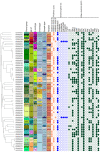Genome Analysis of Klebsiella pneumoniae Reveals International High-Risk Pandemic MDR Clones Emerging in Tertiary Healthcare Settings in Uganda
- PMID: 38003798
- PMCID: PMC10674604
- DOI: 10.3390/pathogens12111334
Genome Analysis of Klebsiella pneumoniae Reveals International High-Risk Pandemic MDR Clones Emerging in Tertiary Healthcare Settings in Uganda
Abstract
Klebsiella pneumoniae is a threat to public health due to its continued evolution. In this study, we investigated the evolution, convergence, and transmission of hypervirulent and multi-drug resistant (MDR) clones of K. pneumoniae within healthcare facilities in Uganda. There was high resistance to piperacillin (90.91%), cefuroxime (86.96%), ceftazidime (84.62%), cefotaxime (84.00%), amoxicillin/clavulanate (75%), nalidixic acid (73.68%), and nitrofurantoin (71.43%) antibiotics among K. pneumoniae isolates. The isolates were genetically diverse, consisting of 20 different sequence types (STs) and 34 K-serotype groups. Chromosomal fosA (for fosfomycin) and oqxAB efflux pump genes were detected in all isolates. Two carbapenem resistance genes, blaNDM-5 and blaOXA-181 plus extended-spectrum beta-lactamase (blaCTX-M-15) gene (68.12%), quinolone-resistant genes qnrS1 (28.99%), qnrB1 (13.04%), and qnrB6 (13.04%) and others were found. All, except three of the isolates, harbored plasmids. While the isolates carried a repertoire of virulence genes, only two isolates carried hypervirulent genes demonstrating a low prevalence (2.90%) of hypervirulent strains. Our study demonstrated genetically diverse populations of K. pneumoniae, low levels of carbapenem resistance among the isolates, and no convergence of MDR and hypervirulence. Emerging high-risk international pandemic clones (ST11, ST14, ST147, ST 86 and ST307) were detected in these healthcare settings which are difficult to treat.
Keywords: hypervirulence; multidrug resistant; resistance genes; virulence.
Conflict of interest statement
The authors declare no conflict of interest.
Figures






Similar articles
-
Multiple Benefits of Plasmid-Mediated Quinolone Resistance Determinants in Klebsiella pneumoniae ST11 High-Risk Clone and Recently Emerging ST307 Clone.Front Microbiol. 2019 Feb 12;10:157. doi: 10.3389/fmicb.2019.00157. eCollection 2019. Front Microbiol. 2019. PMID: 30809206 Free PMC article.
-
Genome dynamics of high-risk resistant and hypervirulent Klebsiella pneumoniae clones in Dhaka, Bangladesh.Front Microbiol. 2023 May 25;14:1184196. doi: 10.3389/fmicb.2023.1184196. eCollection 2023. Front Microbiol. 2023. PMID: 37303793 Free PMC article.
-
Whole genome sequencing snapshot of multi-drug resistant Klebsiella pneumoniae strains from hospitals and receiving wastewater treatment plants in Southern Romania.PLoS One. 2020 Jan 30;15(1):e0228079. doi: 10.1371/journal.pone.0228079. eCollection 2020. PLoS One. 2020. PMID: 31999747 Free PMC article.
-
Global spread and evolutionary convergence of multidrug-resistant and hypervirulent Klebsiella pneumoniae high-risk clones.Pathog Glob Health. 2023 Jun;117(4):328-341. doi: 10.1080/20477724.2022.2121362. Epub 2022 Sep 11. Pathog Glob Health. 2023. PMID: 36089853 Free PMC article. Review.
-
Virulence factors in carbapenem-resistant hypervirulent Klebsiella pneumoniae.Front Microbiol. 2023 Nov 30;14:1325077. doi: 10.3389/fmicb.2023.1325077. eCollection 2023. Front Microbiol. 2023. PMID: 38098668 Free PMC article. Review.
Cited by
-
Multidrug-Resistant Klebsiella pneumoniae Strains in a Hospital: Phylogenetic Analysis to Investigate Local Epidemiology.Microorganisms. 2024 Dec 10;12(12):2541. doi: 10.3390/microorganisms12122541. Microorganisms. 2024. PMID: 39770744 Free PMC article.
-
Tossing the coin of extended-spectrum β-lactamase: prevalence of extended-spectrum β-lactamase-producing Klebsiella pneumoniae isolated from patients with sepsis.Access Microbiol. 2025 Feb 19;7(2):000962.v3. doi: 10.1099/acmi.0.000962.v3. eCollection 2025. Access Microbiol. 2025. PMID: 39981381 Free PMC article.
-
Global Emerging Infections Surveillance Program Contributions to Pandemic Preparedness and Response.Emerg Infect Dis. 2024 Nov;30(14):9-12. doi: 10.3201/eid3014.240305. Emerg Infect Dis. 2024. PMID: 39530771 Free PMC article. Review.
-
Invasive Liver Abscess Syndrome in the Immunocompromised: A Case Report.Clin Case Rep. 2025 Jan 10;13(1):e70108. doi: 10.1002/ccr3.70108. eCollection 2025 Jan. Clin Case Rep. 2025. PMID: 39802363 Free PMC article.
-
Metagenome mining divulges virulent and multidrug resistant Pseudomonas aeruginosa ST242 and Klebsiella michiganensis ST∗1b23 coinfecting an 8-month-old meningitis infant under ICU in Kampala, Uganda, East Africa.Heliyon. 2024 Oct 20;10(20):e39455. doi: 10.1016/j.heliyon.2024.e39455. eCollection 2024 Oct 30. Heliyon. 2024. PMID: 39498086 Free PMC article.
References
-
- Holt K.E., Wertheim H., Zadoks R.N., Baker S., Whitehouse C.A., Dance D., Jenney A., Connor T.R., Hsu L.Y., Severin J., et al. Genomic analysis of diversity, population structure, virulence, and antimicrobial resistance in Klebsiella pneumoniae, an urgent threat to public health. Proc. Natl. Acad. Sci. USA. 2015;112:E3574–E3581. doi: 10.1073/pnas.1501049112. - DOI - PMC - PubMed
-
- Bialek-Davenet S., Criscuolo A., Ailloud F., Passet V., Jones L., Delannoy-Vieillard A.S., Garin B., Le Hello S., Arlet G., Nicolas-Chanoine M.H., et al. Genomic definition of hypervirulent and multidrug-resistant klebsiella pneumoniae clonal groups. Emerg. Infect. Dis. 2014;20:1812–1820. doi: 10.3201/eid2011.140206. - DOI - PMC - PubMed
-
- Liu C., Du P., Xiao N., Ji F., Russo T.A., Guo J. Hypervirulent Klebsiella pneumoniae is emerging as an increasingly prevalent K. pneumoniae pathotype responsible for nosocomial and healthcare-associated infections in Beijing, China. Virulence. 2020;11:1215–1224. doi: 10.1080/21505594.2020.1809322. - DOI - PMC - PubMed
Grants and funding
LinkOut - more resources
Full Text Sources

